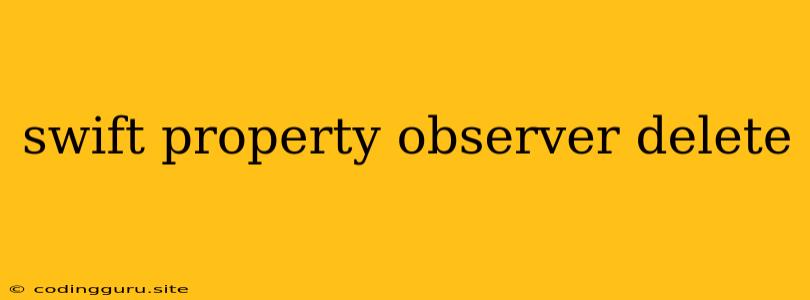Understanding Property Observers in Swift: A Deep Dive with Delete
Property observers in Swift are a powerful tool that allows you to execute code whenever a property's value is about to change or has changed. One of the key use cases for property observers is to handle the deletion of an object. This article explores the concept of property observers and delves into the implementation of a willSet observer specifically designed to trigger the deletion of an object.
What are Property Observers?
Property observers are blocks of code that are automatically executed when the value of a property is modified. Swift offers two types of property observers:
- willSet: This observer is executed before the property's value is set to a new value. It gives you the chance to modify the new value or perform actions based on the upcoming change.
- didSet: This observer is executed after the property's value has been set to a new value. This allows you to react to the change and perform actions based on the updated property value.
The Importance of willSet for Delete Operations
In the context of deletion, the willSet observer is particularly useful because it allows you to trigger cleanup actions before the object is actually deleted. This is crucial for maintaining data integrity and preventing unexpected errors.
Example: Deleting an Object Using willSet
Let's illustrate this with a practical example. Imagine you have a User class that has a name property. You want to implement a mechanism to delete the User object from your system whenever the name property is set to nil.
class User {
var name: String? {
willSet {
if newValue == nil {
// Delete the User object from your system here
// Example: Delete from a database or remove from an array
print("User object will be deleted.")
}
}
}
}
let user = User()
user.name = "John Doe"
// Delete the user object
user.name = nil // This triggers the 'willSet' observer
In this example, the willSet observer checks if the new value is nil. If it is, the code within the observer will be executed, which would typically include deleting the User object from your system.
Advantages of using willSet for Delete Operations
- Early Detection:
willSetallows you to detect the deletion attempt before it actually happens, providing you with an opportunity to perform necessary actions. - Data Consistency: By executing cleanup tasks within the
willSetobserver, you ensure that data remains consistent even after the object is deleted. - Controlled Cleanup: You can implement specific cleanup logic within the
willSetobserver, tailoring it to your exact deletion needs.
Considerations When Using willSet for Deletion
- Object Ownership: Carefully consider the object's ownership and whether you're deleting it in the correct context. Make sure you don't accidentally delete an object that's still being used by other parts of your application.
- Potential Side Effects: Be aware of potential side effects that might arise from deleting the object. For example, consider any dependent objects or references that need to be updated or invalidated.
- Alternatives: Depending on your specific scenario, other approaches like using a dedicated
delete()method might be more appropriate than relying solely onwillSet.
Conclusion
Property observers, particularly willSet, provide a powerful mechanism for controlling object deletion in Swift. By strategically placing the willSet observer on the appropriate property, you can implement seamless and controlled object deletion, ensuring data integrity and preventing unexpected errors. Remember to consider the implications of deletion and implement appropriate cleanup logic to maintain a clean and reliable system.
